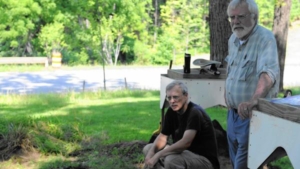
Jim Gibb, right, watches a volunteer help excavate a site at SERC.
A group of scientists and volunteers gathered in July to take part in an archaeological dig at the Smithsonian Environmental Research Center. They worked in the sweltering heat to uncover dozens of artifacts right on the center’s campus. The group is directed by Jim Gibb, an archaeologist who is currently running 14 different projects, all done with citizen scientists. The lab has been doing work like this for 5 years, and their goal is to unearth how humans interacted with their environment in the past.
The group found pig and cattle bones at the site, which was home to 17th century Quakers. This showed that the families that lived there mostly relied on animal husbandry to get their food. They inferred that families here were causing environmental stress by their choice in livestock. The lab wants to conduct digs like this at other 17th century sites to understand how livestock affected the ecosystem.
If you’re interested in volunteering at the lab, contact Gibb at jamesggibb@verizon.net, or contact the center’s citizen science coordinator Alison Cawood at cawooda@si.edu.
